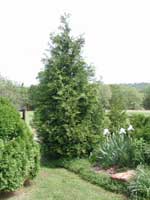Resource Library
Plant of the Week: Green Giant Arborvitae
The University of Arkansas System Division of Agriculture does not promote, support or recommend plants featured in "Plant of the Week." Please consult your local Extension office for plants suitable for your region.
Plant of the Week
Green Giant Arborvitae
Latin: Thuja plicata 'Green Giant'

Arborvitaes a lost much of their appeal amongst gardeners. They refer to them as hopelessly old fashioned and prone to be buggy, with bagworms the most often mentioned affliction.
But, things can change. We can reconsider, especially if a new, pretty face turns our head. This seems to be happening with a new arborvitae that has become a hot seller in recent years.
Green Giant arborvitae is a big, fast-growing evergreen that will probably top out at around 60 feet tall but with a basal spread of around 15 to 20 feet. Its fast growth and natural exclamation mark form makes it ideally suited for screening, especially if you are trying to screen a five-story building.
Plants have bright green, scalelike leaves in the summertime that darken a bit during the winter but never take on the maroon coloration associated with the Oriental arborvitae. The flattened sprays of branches are larger than the American or Oriental arborvitae, but are otherwise similar.
Green Giant was introduced as a single plant to the U.S. National Arboretum in Washington, D. C. in 1967 from Kvistgaard, Denmark. The original plant was discovered in 1937 by nurseryman D. T. Poulsen whose firm was founded in 1878. Poulsen is best known in the horticultural world for work with the hybrid polyantha class rose which is a bridge to the modern florabundas.
The identity of the plant was confused for a time, especially after getting mixed up with a similar clone during propagation and distribution. Finally, in the mid 1990s, using DNA analysis and extensive record searches, the plant was identified as a putative hybrid of Thuja standishii (Japanese Arborvitae) and T. plicata (Western Red Cedar). The name Green Giant was suggested by Tennessee nurseryman Don Shadow.
By the mid 90s the original tree was 30 years old and beginning to attract attention. It was 30 feet tall with a narrow form, blemish free foliage, and much larger than the other arborvitae surrounding it. Wayside Gardens picked it up in the late 1990s and by 2004 it was their top selling item, partly because of the multi-page coverage they gave the plant in their catalogs.
Green Giant arborvitae is destined to become a superstar in the plant world and will become as common as the now much maligned Bradford pear. The reason for its success is two-fold. First, it’s a fast, easy-to-grow plant that, at least so far, has been remarkably pest free. Gardeners like to see things grow, and this plant can make three or four feet of growth a year while young.
The other reason Green Giant will succeed is money. The nursery industry is trying to remake itself in the image of the recording industry with all of the new plants protected by patents and propagation tightly controlled.
But Green Giant, like Bradford pear and Leyland cypress before it, is a public domain plant that anyone can propagate.
Mike Shade, owner of the Botany Shop in Joplin, Missouri, saw the potential of Green Giant in 2000 and began selling the plant over the internet. Last year, he sold more than a quarter million plants, and he’s only one of many propagators growing the plant.
Part of Green Giant’s popularity is because it’s being used to replace Leyland cypress hedges that have begun developing disease problems across the southeast where it has been used extensively in the past quarter century.
Green Giant is a big plant, so use it with caution. It can be pruned into a hedge, but hedging such a potentially large plant must be carefully considered. If an arborvitae hedge ever outgrows its location, it cannot be cut back like a broadleaf plant. It grows best in full sun in a wide range of soil conditions.
Single plants are best used as specimens in the landscape or to face down a tall corner of the home. Once established, Green Giant has good drought tolerance. Bagworms can attack the plant, but so far have not been a serious problem.
By: Gerald Klingaman, retired
Extension Horticulturist - Ornamentals
Extension News - January 27, 2006
The University of Arkansas System Division of Agriculture does not maintain lists of retail outlets where these plants can be purchased. Please check your local nursery or other retail outlets to ask about the availability of these plants for your growing area.